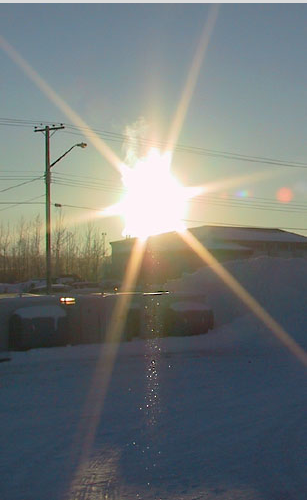Diamond dust lower sun pillar
Diamond Dust Lower Sun Pillar: A Dazzling Display of Atmospheric Optics
Atmospheric optics never fail to astound us with their ethereal beauty. One such phenomenon is the diamond dust lower sun pillar, which mesmerizes observers with its glittering display. In this article, we will delve into the intricacies of this captivating optical phenomenon, exploring its formation, characteristics, and the science behind it.
The Formation of Diamond Dust Lower Sun Pillar
The diamond dust lower sun pillar is created by the presence of "diamond dust" ice crystals suspended in freezing cold air, just a few feet from the observer. These tiny ice crystals act as prisms, refracting and reflecting sunlight to produce a stunning pillar of light below the sun. The sparkles emitted by these crystals serve as a visual testament to the collective glimmers produced by countless individual crystals.
Understanding the Components
To fully appreciate the diamond dust lower sun pillar, it is important to understand its various components. The brightest portion of the lower pillar is an elongated subsun, which occurs when the sun is near the horizon and the ice crystals have large tilts. In such cases, the lower sun pillar and the subsun merge together, creating a radiant spectacle that captivates all who witness it.
Additionally, there is a small upper pillar located above the sun. This upper pillar, although less pronounced than its lower counterpart, adds another layer of enchantment to the overall display. Furthermore, in some instances, a tall and bright diamond dust sundog can also accompany the lower sun pillar, enhancing the visual splendor of the scene.
Capturing the Diamond Dust Lower Sun Pillar
On January 21, 2003, photographer David van Unen had the privilege of capturing this awe-inspiring halo shortly before sunset in Fort St. John, B.C., Canada. His skillful lensmanship immortalized the beauty of the diamond dust lower sun pillar, providing us with a glimpse into this extraordinary atmospheric phenomenon.
The Science Behind Diamond Dust
The formation of diamond dust hinges on a combination of specific atmospheric conditions. It occurs in regions where extremely cold temperatures are accompanied by high humidity. Under these circumstances, ice crystals form and remain suspended in the air, creating a mystical landscape of shimmering particles.
Exploring the Wonders of Halos
The diamond dust lower sun pillar is just one example of the captivating halos that grace our skies. Halos are optical phenomena caused by the interaction of sunlight with ice crystals or water droplets suspended in the atmosphere. These intricate displays can manifest in various forms, including circular halos, sundogs, and arcs. Each halo has its unique characteristics, making every sighting a truly remarkable experience.
A Lesson in Atmospheric Optics
Observing the diamond dust lower sun pillar offers us an opportunity to delve into the fascinating realm of atmospheric optics. By understanding the science behind these phenomena, we gain a deeper appreciation for the intricate interplay of light and matter in our atmosphere. From the formation of ice crystals to their role in refracting and reflecting sunlight, each element contributes to the mesmerizing spectacle that unfolds before our eyes.
Conclusion
The diamond dust lower sun pillar is a testament to the wondrous beauty of atmospheric optics. As we marvel at the glimmering display created by suspended ice crystals, we are reminded of the intricate mechanisms that shape our natural world. So, the next time you witness this ethereal phenomenon gracing the horizon, take a moment to immerse yourself in its splendor and contemplate the secrets it holds. Atmospheric optics continue to fascinate and inspire, reminding us of the boundless wonders that surround us.

Diamond Dust Pillars.
Below the sun (ignore the six-spiked lens flare) a glittering lower sun pillar is formed by "diamond dust" ice crystals floating in freezing cold air just a few feet from the camera. Their sparkles demonstrate that halos are indeed made up of the collective glitters from myriad individual crystals.
The brightest area of the lower pillar is actually an elongated subsun. When, as here, the sun is near to the horizon and the crystals have large tilts, the lower sun pillar and the subsun merge together.
There is a small upper pillar above the sun. A tall bright diamond dust sundog was also present.
David van Unen (more of his images) captured this halo shortly before sunset on January 21, 2003 at Fort St. John, B.C., Canada.
©2003 David J van Unen, shown with permission.
Note: this article has been automatically converted from the old site and may not appear as intended. You can find the original article here.
Reference Atmospheric Optics
If you use any of the definitions, information, or data presented on Atmospheric Optics, please copy the link or reference below to properly credit us as the reference source. Thank you!
-
<a href="https://atoptics.co.uk/blog/diamond-dust-lower-sun-pillar/">Diamond dust lower sun pillar</a>
-
"Diamond dust lower sun pillar". Atmospheric Optics. Accessed on April 25, 2024. https://atoptics.co.uk/blog/diamond-dust-lower-sun-pillar/.
-
"Diamond dust lower sun pillar". Atmospheric Optics, https://atoptics.co.uk/blog/diamond-dust-lower-sun-pillar/. Accessed 25 April, 2024
-
Diamond dust lower sun pillar. Atmospheric Optics. Retrieved from https://atoptics.co.uk/blog/diamond-dust-lower-sun-pillar/.